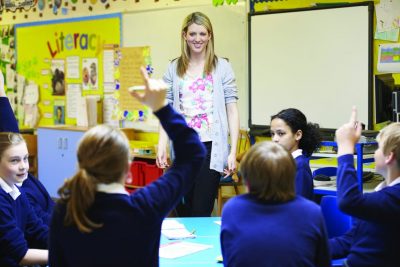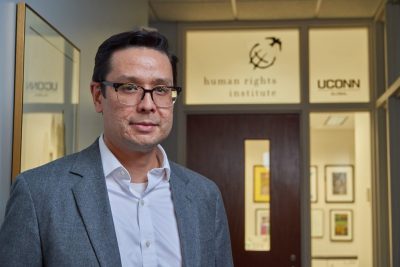UConn Today (Neag School alumna Cécile Sophie Pieper is mentioned as one of 16 Huskies headed to the Games)
Five Weeks at B.R.A.I.N. Camp Could Give Kids a Brighter Future
UConn Today (A summer research collaborative including Neag School’s Devin Kearns is featured)
Testing Strategies to Support Teachers’ Intervention Implementation

Lisa Sanetti is testing the efficacy of PRIME, a system designed to combat the implementation challenges behavioral interventions face in elementary classrooms.
Editor’s Note: The following piece featuring research led by Lisa Sanetti originally appeared in UConn Today.
Researchers have spent decades developing evidence-based interventions to prevent disruptive behaviors that interfere with instruction elementary classrooms. Educators often struggle to fully implement these interventions consistently.
As a result, students’ behavior does not improve. Simply put, students can’t benefit from interventions, even those that are evidence-based, if they don’t receive them.
When students’ behavior doesn’t improve, students are often referred to more intensive intervention, expensive special education services, or more restrictive placements. This outcome could be avoided for many students if educators are provided support to implement less-intensive interventions fully and consistently over time.
Neag School of Education professor of educational psychology Lisa Sanetti has received a $3.7 million grant from the Department of Education Institute of Educational Sciences (IES) to test the efficacy of a theory-driven system for improving intervention implementation in elementary schools.
Sanetti is collaborating with Co-PIs Melissa Collier-Meek ’08 (CLAS), ’09 MA, ’11 6th Year, ’13 Ph.D. and Nedim Yel at the University of Massachusetts, Boston. Collier-Meek received her Ph.D. in educational psychology from UConn’s Neag School of Education.
Sanetti’s team will use the Planning Realistic Intervention implementation and Maintenance by Educators (PRIME) system. The group previously designed PRIME through an IES grant and will evaluate its efficacy in this new study working with elementary school teachers implementing behavioral interventions for students with or at risk of disabilities.
“Decades of research and billions of dollars devoted to developing evidence-based interventions to improve student outcomes are not achieving their potential impact due to inadequate implementation.”
—Professor Lisa Sanetti
“Decades of research and billions of dollars devoted to developing evidence-based interventions to improve student outcomes are not achieving their potential impact due to inadequate implementation,” Sanetti says. “PRIME may provide a feasible, low-cost approach to supporting educators’ intervention implementation and maximizing outcomes for students.”
Previous studies of strategies to support teachers’ intervention implementation lacked theoretical support, meaning how they affected change was unknown making it difficult to generalize and reapply the findings.
PRIME is based on a proven health psychology theory of adult behavior change. The individualized, tiered, consultation system helps teachers move from intending to implement an intervention to actually putting it in place with fidelity over time.
In PRIME, all teachers work with a consultant to make sure the logistics of implementing an intervention are clear and fit the routines and culture of their classroom. It also helps teachers plan around potential barriers by developing solutions to remediate them proactively.
In their previous studies, they found most teachers, after one planning session, were able to fully and consistently implement behavioral interventions for more than two months after the session, resulting in meaningful student improvements.
Some teachers needed more support; those teachers fall into two major camps: those who didn’t have the skills to implement the intervention (skill deficit) and those who had the skills but struggled with consistency (performance deficit).
The researchers found that modeling and role play increased fidelity for those with skill deficits while performance feedback and motivational interviewing increased fidelity for teachers with performance deficits. The group will use this knowledge to target interventions for individual educators in the new study.
Sanetti’s team will randomize three cohorts of teachers from elementary schools around UConn and UMass Boston. They will use a diverse sample of schools of different sizes, demographics, community types, and administrative support. This will allow the researchers to generalize their findings to many types of schools.
The researchers will collect data about intervention fidelity and student outcomes, including disruptive behavior and academic engagement, over the course of the five-year study to determine the efficacy of PRIME.
Sanetti holds a Ph.D. in educational psychology from the University of Wisconsin-Madison. Her research interests include implementation science, educator well-being, and school-based mental health.
Related Story:
Windsor Hires 2 New Elementary School Principals
Journal Inquirer (Neag School alumni Jennifer Michno and Felicia Poskus are featured for being hired as principals)
Reshaping Education
Barbados Today (Rachael Gabriel is interviewed about learning loss)
Opportunity in Crisis: Investing in Educational Equity with Ed. Secretary Miguel Cardona
Washington Post (Neag School alumnus and U.S. Education Secretary Miguel Cardona is featured; Neag School is mentioned)
Neag School Researcher Testing Strategies to Support Teachers’ Intervention Implementation
UConn Today (A new IES research grant led Lisa Sanetti is featured)
Creativity May be Key to Healthy Aging. Here’s How to Stay Inspired.
Washington Post (James Kaufman is quoted about creativity and healthy aging)
Lutz Children’s Museum Announces New Executive Director
Lutz Children’s Museum (Neag School alumna Patricia Buxton is featured about her new role)
Meet the Researcher: Glenn Mitoma

Glenn Mitoma has spent his career studying human rights and helping others understand how they can realize them in their communities.
Editor’s Note: The following piece featuring Glenn Mitoma was originally published in UConn Today.
Glenn Mitoma understands that questions of human rights require careful inquiry and extensive collaboration. His work aims to increase the realization of human rights through education and community programs.
Mitoma graduated from the University of California, Santa Cruz with a bachelor’s degree in photography. After working for a stock photo company, Mitoma went back to school.
Mitoma was interested in an interdisciplinary academic program that engaged culture, which he found at Claremont Graduate University’s cultural studies program.
“That was a space I was very comfortable in and very interested in,” Mitoma says.
During graduate school, Mitoma’s focus shifted from art and art history and toward history and human rights. His dissertation focused on the history of the Universal Declaration of Human Rights, a milestone document first crafted in 1948 by the United Nations General Assembly.
Mitoma joined UConn in 2008 as a postdoctoral fellow, and is now an assistant professor in the Neag School of Education and a joint appointment in the Human Rights Institute.
Reinvestigating History
Mitoma was in graduate school when the World Trade Center was attacked on Sept. 11, 2001. This event caused a significant shift in discussions about the United States and human rights.
“Part of the shift in perspective that took place in the wake of those attacks was to really interrogate the role of the United States in the global order,” Mitoma says.
Since the aftermath of World War II, the US had largely been recognized as a vocal champion of human rights. But after 9/11, scholars began questioning this characterization given the US’s imperialist foreign policies, and applied a cultural relativist framework which calls for not judging the actions of a person from a different culture by the norms and standards of one’s own.
In this atmosphere, Mitoma became interested in studying the contributions of intellectuals and diplomats from outside the US and Europe to the development of the human rights regime.
“Part of the shift in perspective that took place in the wake of those attacks was to really interrogate the role of the United States in the global order.”
— Assistant Professor Glenn Mitoma
When Mitoma entered the field, there were two scholastic camps on this topic. The first held that the idea of human rights that emerged in the 1930s and 40s was an assertion of Western power. They characterized any non-western intellectuals who participated in this development as internally westernized.
The second group claimed that human rights represents the concerns of marginalized and oppressed peoples. In this framework, human rights is a legitimate method of working toward a more just, equitable global society.
Mitoma revealed a much more complex portrait of this topic through his work on two diplomats and thinkers: Charles Malik, a Lebanese academic, diplomat, and politician; and Carlos Romulo, a Filipino diplomat and writer.
Both men attended American schools and worked with the US government throughout their careers. However, they also worked to adapt the discourse of human rights to apply to the concerns of their own countries.
“It’s not simply a matter that they had been westernized and were mouthpieces for a particular Western perspective,” Mitoma says. “But rather, they shaped, rearticulated, and pushed the discourse of human rights in a universalizing direction.”
Mitoma is currently working with undergraduate student Sage Phillips and a team from Greenhouse Studios on a project that sheds light on how UConn, as a land grant institution, is tied to the displacement of indigenous tribal communities in the western US.
The Morrill Land Grant Acts established universities like UConn using funds from the sale of federal lands taken from indigenous tribes through unequal treaties or violence.
Mitoma will investigate the specific pieces of land that funded UConn, which tribes were displaced from this sale, the revenue raised from the sale, and how those funds have been used within the University. This research will help address what UConn’s history means for its current responsibility to indigenous communities.
“This work ties together this important historical and archival work and helps connect the university to stakeholders which have been rendered invisible by colonialism,” Mitoma says. “It asks the university not only to be an academic home to people who student native and indigenous issues but actually, as an institution, take responsibility for their own culpability in the long history of colonization.”
Education and Human Rights

Mitoma is interested in the historical role education played in the development of the human rights regime and how it can continue to develop understanding of human rights for students today.
This work breaks away from traditional human rights scholarship, which tends to focus on the legal and political history of these ideas.
“I’m interested in a less spectacular, but essential, pedagogical function in human rights, and the way that they shape both education systems and structures and how students incorporate and learn these values and deploy them at different points in their own lives and careers,” Mitoma says.
This work increases understanding of how to bridge the gap between high-level policy and declarations that often have little to no impact on the ground, and real change for people’s lived experiences.
Mitoma is also interested in reversing the trend of education in the US that places almost exclusive emphasis on the common core and standardized testing and education as a means of increasing an individual’s potential earning capacity.
Refocusing education on human rights can help students recognize their individual human rights, as well as how to uplift a community and contribute to collective wellbeing, he says.
“On both sides, from a human rights perspective and from an education perspective, bridging that gap is an essential need within scholarship,” Mitoma says.
Mitoma is currently working on a project investigating the intersection between human rights and civics education in Connecticut high schools.
The goal of this work is to determine the impact of a human rights-centered civics education on students’ community engagement, teachers’ connections with organizations that promote democracy at the community level, and how the schools themselves engage in democratic practices.
Crossing Borders
Mitoma serves as the director of the Dodd Human Rights Impact. The programs that are part of the Dodd Human Rights Impact work with Connecticut communities to foster a culture of human rights in the state and beyond.
“We need everybody’s voice, we need everybody’s perspective if we’re going to create communities that work for everyone.”
— Glenn Mitoma
“We really see this as an extension of the University’s responsibilities not only around undergraduate and graduate education and research, but also to be of service to communities near and far,” Mitoma says.
The Dodd Human Rights Impact collaborates with on-campus groups and community partners such as the Hartford Public Library and Everyday Democracy, a community organization that focuses on racial equity.
The human rights challenges people face in Connecticut and across the globe require interdisciplinary thinking and collaborating with those who have different ideas, skills, and backgrounds. This approach also gives the programs greater reach and impact.
“Working across these lines is functionally better, but it’s also better as an emblem of democratic values,” Mitoma says. “We need everybody’s voice, we need everybody’s perspective if we’re going to create communities that work for everyone.”
Mitoma says the most rewarding part of his work is collaborating with others to address complex, critical questions that have the capacity to improve the realization of human rights at all levels.
“Participating in scholarly conversations can be a challenge when you’re crossing borders all the time in your work,” Mitoma says. “I’ve addressed that by having good partners and collaborators and finding others who know more than I do. Working together, we’re better than the sum of our parts.”
Mitoma’s research career has largely been shaped by the state of the world around him and where he saw his research making the biggest impact for the moment, a thread he sees continuing.
“I really do see my research as continuing to be responsive to what I see as the needs of the communities that I’m a part of,” Mitoma says.
